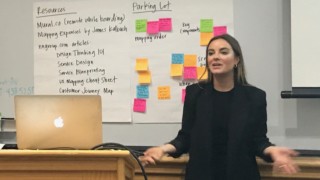Talking UX with Limina
Limina’s UX Specialist Lisa Hilmes and Senior UX Specialist Ellie Krysl recently traveled to Boston to attend Talk UX, an international design and technology conference led by women. This Q&A blog post will highlight some of what they learned and trends in the User Experience landscape.
Q: Given that this is a UX conference geared toward women, do you feel there is a shortage of women in the UX field?
Lisa: My perception isn’t so much that there is a lack of women in UX, but I do think in the tech scene in general, there is a lack of women, especially a lack of women leadership – and that goes for UX and tech as a whole. I do think there are a ton of women joining the UX field. And that’s really exciting.
Q: In terms of educational background, what are some of the different paths to UX?
Ellie: I think there is no single pathway to UX. I think that’s a good thing because you don’t want everybody to come from that same pool. Because it is such a broad discipline, it’s better to have a lot of different backgrounds and perspectives come into it. My degree was in Visual Communication and Design and Lisa’s was in Industrial Design. Today, some colleges offer a UX major, but that is still relatively new.
Q: Can you comment on any of the sessions at the conference that really resonated with you?

Ellie: There was a session called “The Make-Up of Design Leadership” that was excellent. The panelists were Libby Maurer (@LibbyMMaurer) of HubSpot, Amy Cueva of Mad*Pow, Kate Brigham (@kbrigham) of ezCater, Susan Rice (@sriceux) of Toast and moderator Danielle Barnes (@daniellesheryce) of Women Talk Design. (Here’s a video of the session.) One of the points that I took away from the session was that management and leadership aren’t necessarily the same thing. I really like that insight, and the idea of not creating a strategy and then hiring to try to fill it, but instead try to find people that are passionate and build disciplines around them because it will be more extensible, and the people have greater longevity in their jobs that way.
Lisa: During that session, Amy Cueva (@amycueva), the founder, and Chief Experience Officer at Mad*Pow, stood out in terms of having the most non-traditional route to UX. She was not only hilarious but also very poignant. One of the things she said that made us all laugh was, “Be your own best friend. Take that negative voice and punch it.” She was referring to the imposter syndrome that a lot of women (but also a lot of men) feel in UX design. Because there isn’t a traditional route, no one feels like they belong.
Another message that I thought was really important in terms of leadership is to empower other women and build up the people around you and build your teams so that the members on the team can shine.
Q: I understand you both went to the Services Blueprinting workshop. Can you talk about that?\

Lisa: Services Blueprinting is a process that a lot of designers are thinking of and using right now. The talk was given by Sarah Gibbons (@segibb) from Nielsen Norman Group, a big thought leader in the UX world, and their concept is founded on the fact that UX design isn’t just interface design. There’s so much more that goes into creating, not only a good experience for the end users but a seamless procedure of giving that service to the user. So, Service Blueprinting is one method of mapping out all of the actions and splitting them up, and also looking at how they’re interacting with the non-human actors like systems. (See a short video on Service Blueprinting by Sarah Gibbons.)
Q: Any other outstanding sessions you attended that have immediate relevance to projects you are working on?

Lisa: There was a talk called “Wicked Digital Problems” by Lola Oyelayo (@LolaOye), a digital product strategist, which really resonated with me in terms of a project we’re just starting in on right now. She put up a quote from Albert Einstein that said, “We cannot solve the problems we have created with the same thinking we used in creating them.” That made a lot of sense to me.
Part of her talk was about how UX Design isn’t a process only for UX designers. You have to bring in the technical people and the back-end developers into the process. And you as a designer have to carry your work throughout development. You can’t just hand it off to developers and say, okay, my part is done.
Q: How will the learnings from this conference help you in your job?
Ellie: People were extremely candid and able to shine some light on common pain points we encounter as UX practitioners, much like we do when we’re working with users. By involving leadership, listening to each other, and listening to developers, we set ourselves up better for success. Those aren’t necessarily new ideas, but it was interesting to learn that no matter the size of the company, whether an in-house team or consultancy, we’re all striving to continually find those similar places where better practices can be applied.
Q: Any closing thoughts?
Lisa: I thought the conference offered a creative feeling of comradery in an industry that – from my experience – has been very competitive. It was refreshing to not feel like I was competing against everyone else in the room.
Thanks to Talk UX for a great conference Word on the street is that Talk UX 2019 will be held in Stockholm, and the Limina team is looking forward to it!